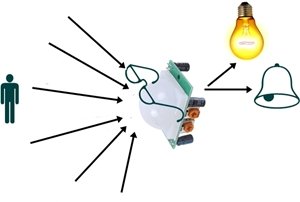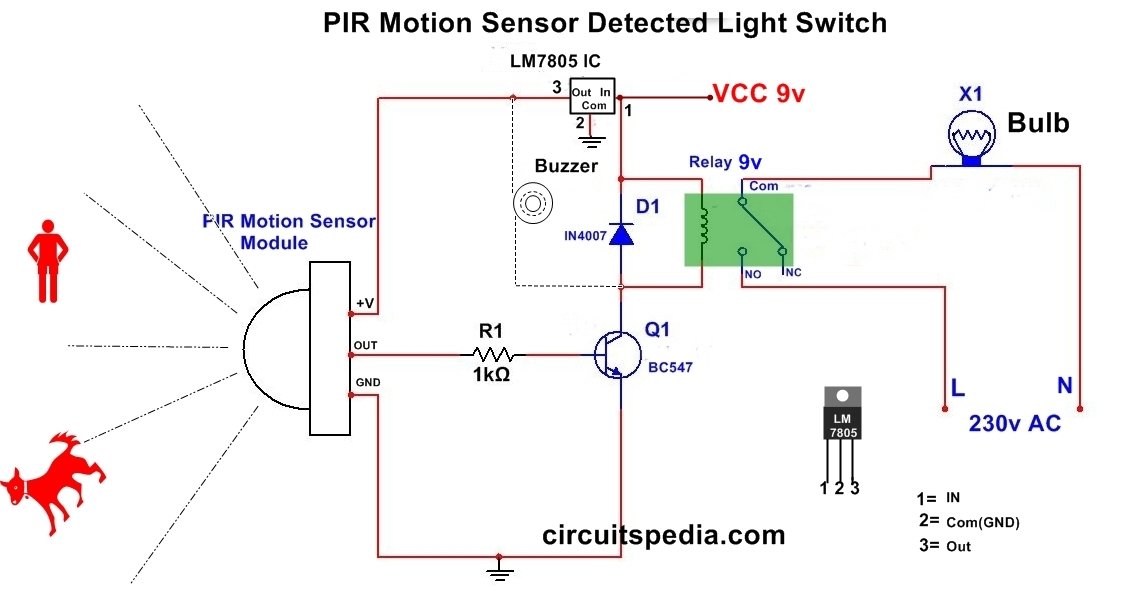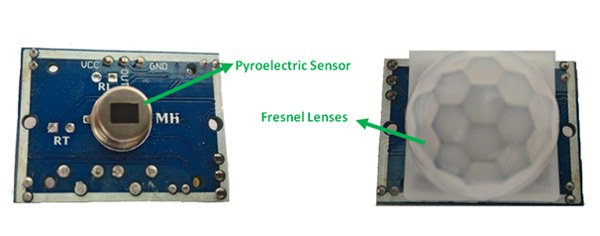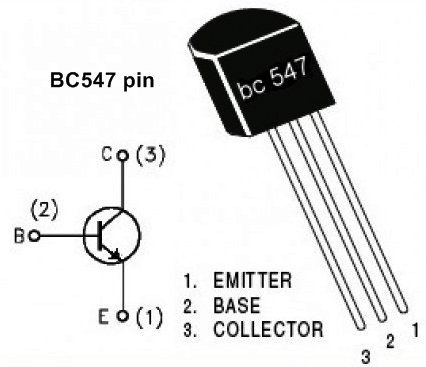PIR Motion sensor Alarm circuit
What is a PIR Sensor? | A Complete Guide for Beginners.
Have you ever walked into a room and seen the lights turn on automatically? Or maybe you’ve seen a motion-activated security light that turns on when someone walks past? When someone enters a room to triggers security alarms when motion is detected; this small device makes our environments smarter and safer. Behind these smart actions is a tiny but powerful component known as a PIR sensor.
But what exactly is a PIR sensor, and how does it work? In this blog post, we’ll explore everything you need to know about PIR sensors—from the technology behind them to their practical uses in everyday life.
In this article, we’ll dive deep into what a PIR sensor is, how it functions, where it’s used, and why it’s become one of the most popular sensors in electronics and automation today.
PIR stands for Passive Infrared. A Passive Infrared (PIR sensor) is an electronic device that detects infrared (IR) radiation emitted by objects, especially warm-blooded animals and humans, in its field of view. The term “passive” means the sensor does not emit any infrared energy of its own. Instead, it detects the natural infrared radiation that radiates from objects due to their temperature. All living beings emit infrared radiation, which the PIR sensor can detect when there is motion.
In this article, we’ll dive deep into what a PIR sensor is, how it functions, where it’s used, and why it’s become one of the most popular sensors in electronics and automation today.
How Does a PIR Sensor Work?
1. Dual Infrared Sensors
A PIR sensor consists of two slots made of a special material that is sensitive to infrared. When the sensor is idle, both slots detect the same amount of IR radiation from the surroundings.
When a warm body like a human or animal moves across the sensor’s field of view, it causes a sudden change in infrared radiation. One slot detects more radiation than the other, and this difference triggers the sensor, signaling that motion has occurred.
Most PIR sensors come with a Fresnel lens that helps focus the IR signals and increase the coverage area.
2. Fresnel Lens
To improve its detection capabilities, PIR sensors are often equipped with a Fresnel lens. This special lens helps focus infrared radiation onto the sensor and increases the effective detection range and coverage angle.
3. Detection Range
Most PIR sensors can detect motion within a range of 6 to 12 meters, with a field of view between 90° and 180°, depending on the design and placement.
In Simple Terms:
A PIR sensor detects motion based on heat changes in its surroundings. It doesn’t care if you’re a human, a dog, or even a cat—if something warm moves, it knows.
Components of a PIR Sensor Module
Here are the main parts of a standard PIR sensor module:
- Pyroelectric Sensor: Detects infrared radiation.
- Fresnel Lens: Focuses IR radiation onto the sensor.
- Signal Conditioning Circuitry: Converts raw sensor signals into usable output.
- Output Pin: Sends a HIGH signal when motion is detected.
- Sensitivity & Delay Time Adjusters: Allow control over range and output duration.
In This Circuit PIR (Passive infrared) Motion Sensor Is used which is used as a motion Detector. When Any Person, Animal, or object comes within range of the sensor. then Automatic Light Switched on. This Can Also be used in Automatic Room lighting. When Any Person enters The Room, the light automatically turns on.
• PIR Sensor is highly sensitive to any Motion/Movement of Anything Around This Range.
- Use 9v DC to operate this circuit, But Make sure that the Sensor requires only 5v DC, so use a 5v voltage regulator LM7805.
- The Vcc pin of the Sensor Is Connected with 5v Dc, the Ground Pin Is connected With Negative DC Supply and the Output Of the Sensor Is Connected With the BASE Of the NPN Transistor (Here, BC547 is used).
- Use a 9v Relay For connecting any Light And Make the Circuit As Relay Get supply 9v And Rest Part of Circuit Get 5v.
- If There is no movement Or Motion occurs, then the Sensor gives a LOW output and the Transistor Is Turned Off Because There is No input of the BASE terminal. When any Motion/Movement occurs, it is detected by the Sensor, And Its Output Is High. Because The Output Is HIGH, The Transistor Gets High input at the BASE and it Turns ON, and the Relay is activated. As Relay is activated the Light connected with this will Switched ON.
- The output of the sensor is automatically LOW after a time duration set by the user. So the Alarm Or Light Which Is connected is Automatically Switched Off After Some Time.
- If you want to use only the alarm, then there is no need to relay it, and the alarm is directly connected with a collector of transistors and a power supply. But that time uses only 5v directly, no need to use any regulator.
- This Circuit of the Security Alarm Using the PIR sensor is Also Works At Night in the Dark. So this is very useful for Security Alarm And Security Light Uses.
- The sensor is covered with a Special Plastic lens for detecting the Maximum Range of area. It has 2 preset: one is the Adjustment of Sensitivity of its and the second is The Adjustment Of Time Delay Which remains high at Output For A Duration.
There are many Different PIR Sensor modules from Fig Given in the image in Looking and circuit structure. But the Working Mechanism is the Same For All.
Note – At Starting When Switch ON the Circuit, PIR Sensor Can Take 10-15 second Time To Adjustment of Stability And Then Starts Working Properly. So Wait For Some Moment When Circuit ON.
Demo Video
Applications of PIR Sensors
PIR sensors are used in countless real-world applications, especially where motion detection is needed. Here are some common examples:
1. Security Systems
Motion detection is essential for alarms and surveillance. PIR sensors help detect unauthorized movement and can trigger alarms, lights, or camera recordings.
2. Smart Lighting
PIR sensors are commonly used in automatic lighting systems, turning lights on when motion is detected and off after a period of inactivity—perfect for saving energy.
3. Home Automation
PIR sensors form the backbone of smart home automation, helping in controlling HVAC systems, lights, and even doors based on human presence.
4. Streetlights
Some modern streetlights use PIR sensors to brighten when a vehicle or pedestrian approaches and dim when there is no movement.
5. Office and Commercial Buildings
Used to control lighting and air conditioning based on occupancy, making buildings more energy-efficient.
Advantages of PIR Sensors
- ✅ Low Power Consumption
- ✅ Cost-Effective
- ✅ Compact and Lightweight
- ✅ Simple to Interface with Microcontrollers
- ✅ Reliable Motion Detection
- ✅ No Radiation Emission (Safe for Humans)
Must Read Dark sensor Circuit

Limitations of PIR Sensors
- ❌ Cannot Detect Stationary Objects
- ❌ Not Effective Through Walls or Glass
- ❌ Affected by Ambient Temperature Changes
- ❌ Limited Range and Viewing Angle
Despite these limitations, their simplicity and efficiency make them ideal for a wide range of consumer and industrial devices.
Frequently Asked Questions (FAQ)
Q1: Can PIR sensors detect through glass or walls?
A: No. PIR sensors cannot detect motion through solid objects like glass, walls, or doors, as these materials block infrared radiation.
Q2: Are PIR sensors safe?
A: Absolutely. They are passive sensors that do not emit any radiation and are perfectly safe for humans and animals.
Q3: Do PIR sensors work in the dark?
A: Yes. Since they detect infrared heat, not visible light, they work just as well in total darkness.
Q4: Can I adjust the sensitivity of a PIR sensor?
A: Yes. Most PIR modules come with adjustable potentiometers that let you change the detection range and delay time.
Q5: What is the difference between PIR and motion sensors?
A: PIR sensors are a type of motion sensor that uses infrared detection. Other motion sensors might use ultrasonic, microwave, or radar technologies.
Final Thoughts
PIR sensors may be small, but they play a huge role in making our world more efficient and secure. Whether it’s your home lights turning on automatically or your security camera springing into action, chances are a PIR sensor is quietly doing its job.
As the Internet of Things (IoT) and automation continue to grow, PIR sensors will remain one of the most critical components in smart systems—affordable, efficient, and reliable.
Whether you’re a DIY electronics hobbyist, a home automation enthusiast, or simply curious about motion detection, understanding how PIR sensors work gives you insight into the smarter technologies shaping our everyday lives.
Must Read ON OFF Touch Switch Circuit






Very nice , good effort sir .
Thank you for giving information
Most Welcome
Good work bro
Hi….could you please give me a best transformerless ac to dc 9v convert circuit?